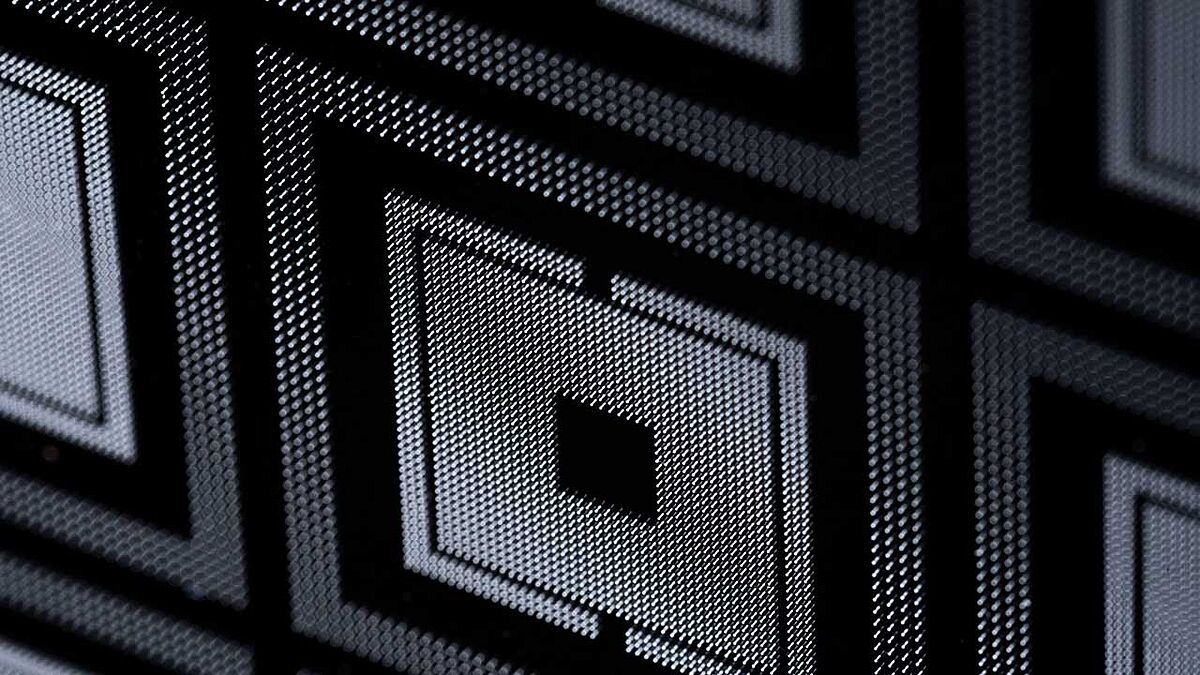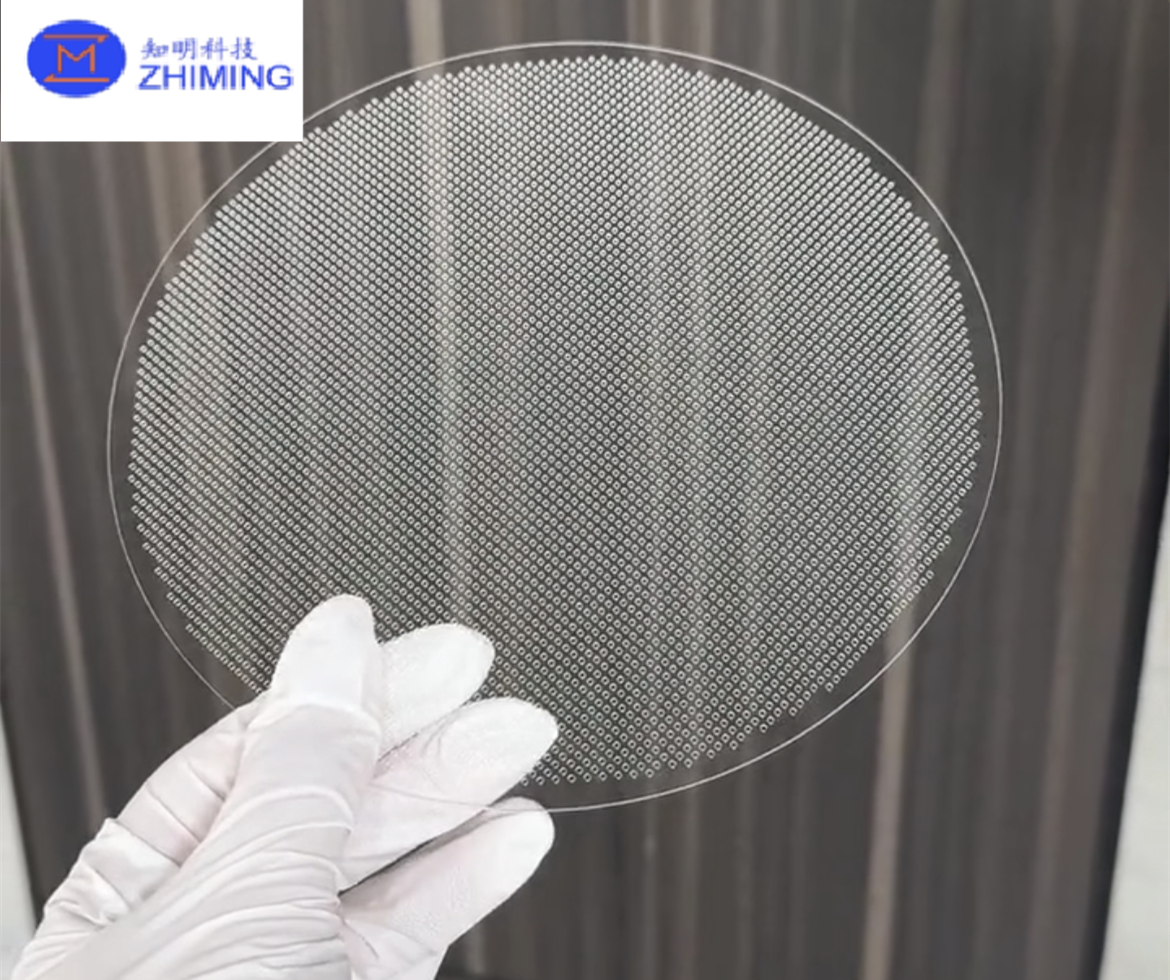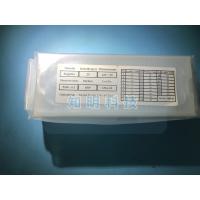Through glass vias (TGV),JGS1 JGS2 sapphire BF33 quartz
Customizable dimensions, thickness can low as 100 µm.
Product abstract
Our innovative Through-Glass Vias (TGV) technologies revolutionize
electrical interconnect solutions, offering unprecedented
flexibility and performance across various high-tech industries.
Utilizing a selection of premium materials such as JGS1, JGS2,
sapphire, BF33, and quartz, our TGV products meet the stringent
demands of precision and durability.

Key Features and Advantages
Material Diversity: Our TGV offerings are crafted from high-quality materials
including JGS1 and JGS2 glasses, known for their exceptional
optical clarity and thermal stability; sapphire, which provides
outstanding hardness and scratch resistance; BF33 glass, renowned
for its thermal and mechanical properties; and quartz, appreciated
for its high purity and chemical resistance.
Customization: We provide fully customizable dimensions tailored to client
specifications, ensuring optimal integration with existing systems.
The thickness of our TGV products can be as low as 100 µm,
accommodating ultra-thin applications and enhancing device
compactness.
Enhanced Performance: The use of superior materials like sapphire and quartz in TGV
technology significantly improves device performance by enhancing
thermal management and reducing signal losses. This leads to more
efficient operation and prolonged device life.
Reliability and Durability: Our TGV products are engineered to withstand harsh conditions,
making them suitable for use in high-reliability sectors such as
aerospace, military, and medical devices. The resilience of
materials like sapphire and JGS glass ensures long-term reliability
and performance under extreme environmental conditions.
Technological Superiority: Incorporating advanced TGV technology enhances the electrical
performance by providing a direct pathway for signal and power
transmission through the substrate, which minimizes impedance and
increases the speed of electronic devices.
Market Flexibility: Suitable for a wide range of applications from consumer
electronics to specialized industrial equipment, our TGV products
are versatile and adaptable to both mass-market and niche
technological needs.
Our advanced TGV technology, coupled with our commitment to
customization and quality, makes us a leader in the field, ready to
meet the evolving challenges of modern industries. Choose our TGV
solutions for unparalleled performance and reliability.

Material characteristics
Our Through-Glass Vias (TGV) products are engineered using top-tier
materials such as JGS1, JGS2, sapphire, BF33, and quartz, each
chosen for its unique properties that enhance device functionality
and durability. These materials allow for customizable dimensions,
with thicknesses that can be reduced to as low as 100 µm,
facilitating integration into various device architectures without
compromising performance.
- JGS1 and JGS2: Both materials are known for their excellent optical
transparency and high thermal stability, making them suitable for
applications requiring minimal optical distortion and high
temperature resistance.
- Sapphire: This material is incredibly durable and offers
exceptional scratch resistance and hardness, ideal for environments
where physical wear and tear are concerns.
- BF33: Known for its robust mechanical properties and thermal
stability, BF33 is optimal for applications that undergo frequent
temperature fluctuations.
- Quartz: With its high purity and low thermal expansion, quartz is
excellent for high-precision applications that require stable,
reliable performance under thermal stress.
Image




Working Principle of TGV Technology
Glass Substrate Selection: Initially, suitable glass materials such as JGS1, JGS2, BF33, or
quartz are selected. These materials are chosen for their excellent
optical, electrical, and thermal stability characteristics.
Drilling: Techniques such as laser drilling, ultrasonic drilling, or
photolithography are used to precisely create vias in the glass
substrate. The diameter and placement of these vias are controlled
according to design requirements.
Metalization of Vias: To enable the vias to conduct electrical signals, their inner
walls are coated with a metal layer. Common metallization materials
include copper, tungsten, or gold. The metallization process may
involve chemical vapor deposition (CVD), physical vapor deposition
(PVD), or electroplating.
Packaging and Interconnection: Once metallization is complete, the vias in the glass can
directly connect to circuits on semiconductor chips or other
electronic components. This vertical interconnection approach helps
reduce wiring space and enhance integration.
Testing and Encapsulation: After metallization and interconnection are complete, the entire
assembly is tested to ensure that the electrical performance meets
specifications. Subsequently, the assembly is encapsulated to
provide physical and environmental protection.
Advantages of TGV Technology:
Reduced Signal Path Length: By making direct connections through the glass substrate, signal
path length is significantly reduced, thereby lowering signal delay
and improving processing speed.
Increased Device Density and Functional Integration: TGV allows for more compact layouts, aiding in the increase of
functional density in electronic devices.
Enhanced Thermal Management: Metallized vias effectively conduct heat, aiding in improved
thermal management of the chip.
Enhanced Dvice Reliability: TGV technology enhances overall device reliability and durability
by reducing the number of interconnections and their complexity.
TGV technology provides an efficient and reliable interconnection
solution for modern microelectronic devices, particularly suitable
for applications requiring high performance and reliability, such
as aerospace, military, and advanced communication systems.
Application Summary
Through-Glass Vias (TGV) technologies are reshaping the landscape
of various high-tech industries by providing innovative,
customizable, and high-performance interconnect solutions. Our
advanced TGV products utilize top-tier materials such as JGS1,
JGS2, sapphire, BF33, and quartz, each chosen for their unique
properties to meet diverse application needs across different
sectors.
Aerospace and Aviation:In aerospace applications, reliability and precision are paramount.
Our TGV technology, using materials like sapphire and BF33 glass,
offers exceptional durability and resistance to extreme
environmental conditions. This ensures reliable performance in
critical systems such as avionics, satellite communications, and
spacecraft instrumentation, where failure is not an option.
Military and Defense:For military applications, our TGV products provide robust and
secure communication links in equipment exposed to harsh
operational conditions. The thermal and mechanical stability of JGS
glasses makes them ideal for use in ruggedized electronics,
targeting systems, and secure communication devices that require
consistent performance in varying climates and under physical
stress.
Medical Devices:In the medical sector, the precision and biocompatibility of
materials like quartz and sapphire are crucial. Our TGV solutions
enhance the functionality of diagnostic and therapeutic devices,
such as imaging systems and wearable health monitors. The
ultra-thin, customizable dimensions of our TGV products allow for
their integration into compact medical devices, improving patient
comfort and device efficacy.
Consumer Electronics:Our technology significantly benefits consumer electronics by
enabling thinner, more efficient devices. The customizable
thickness down to 100 µm allows for sleeker designs in smartphones,
tablets, and wearable technology. The superior electrical
performance facilitated by our TGVs enhances device speed and
battery life, offering consumers more powerful and reliable
gadgets.
Industrial and Scientific Instrumentation:In industrial and scientific applications, the chemical resistance
of quartz and the optical clarity of JGS glasses make our TGV
products ideal for sensors and instrumentation in harsh chemical
environments or precision optical systems. They provide reliable
and accurate data transmission, essential for industrial automation
systems and laboratory equipment.
Our TGV technologies, supported by a range of high-quality
materials and customization options, are pivotal in advancing the
capabilities of devices across multiple sectors. By choosing our
TGV solutions, industries can leverage the benefits of enhanced
performance, increased reliability, and greater flexibility, ready
to meet the demands of modern technology and innovation.
Key words:
Through-Glass Vias (TGV)
TGV glass
TGV sapphire
Interconnect Solutions
Advanced Semiconductor Technology
















